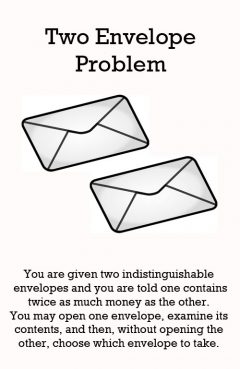Two Envelopes Problem (aka The Exchange Paradox)

Release Date: //
Country of Release:
Length:
MPAA:
Medium: Paradox
Genre:
Release Message: You are given two indistinguishable envelopes and you are told one contains twice as much money as the other. You may open one envelope, examine its contents, and then, without opening the other, choose which envelope to take.
Description: The two envelopes problem, also known as the exchange paradox, is a brain teaser, puzzle, or paradox in logic, philosophy, probability, and recreational mathematics. It is of special interest in decision theory, and for the Bayesian interpretation of probability theory. Historically, it arose as a variant of the necktie paradox. The problem: You have two indistinguishable envelopes that each contain money. One contains twice as much as the other. You may pick one envelope and keep the money it contains. You pick at random, but before you open the envelope, you are offered the chance to take the other envelope instead. It can be argued that it is to your advantage to swap envelopes by showing that your expected return on swapping exceeds the sum in your envelope. This leads to the absurdity that it is beneficial to continue to swap envelopes indefinitely. Example: Assume the amount in my selected envelope is $20. If I happened to have selected the larger of the two envelopes, that would mean that the amount in my envelope is twice the amount in the other envelope. So in this case the amount in the other envelope would be $10. However if I happened to have selected the smaller of the two envelopes, that would mean that the amount in the other envelope is twice the amount in my envelope. So in this second scenario the amount in the other envelope would be $40. The probability of either of these scenarios is one half, since there is a 50% chance that I initially happened to select the larger envelope and a 50% chance that I initially happened to select the smaller envelope. The expected value calculation for how much money is in the other envelope would be the amount in the first scenario times the probability of the first scenario plus the amount in the second scenario times the probability of the second scenario, which is $10 * 1/2 + $40 * 1/2. The result of this calculation is that the expected value of money in the other envelope is $25. Since this is greater than my selected envelope, it would appear to my advantage to always switch envelopes. A large number of solutions have been proposed. The usual scenario is that one writer proposes a solution that solves the problem as stated, but then another writer discovers that altering the problem slightly revives the paradox. In this way, a family of closely related formulations of the problem have been created, which are discussed in the literature. No proposed solution is widely accepted as correct.[1] Despite this it is common for authors to claim that the solution to the problem is easy, even elementary.[2] However, when investigating these elementary solutions they often differ from one author to the next. In the last two decades, several new papers have been published every year.[3]